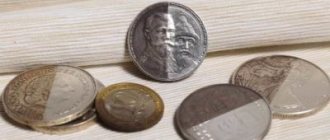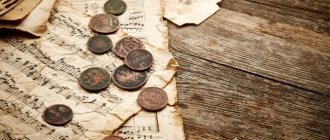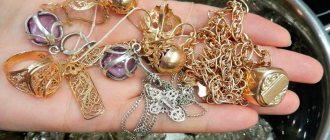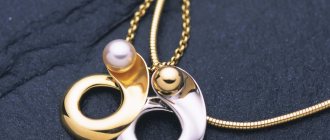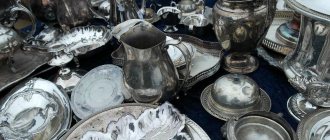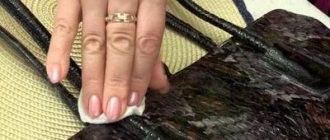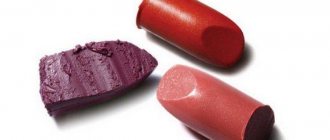Beginning numismatists and treasure hunters are often faced with the issue of cleaning copper coins. Is it possible to do this at home? You can clean antique or old coins with ammonia, vinegar, or mechanically. It is important to choose the right recipe so as not to damage the surface and spoil a valuable specimen.
Dirt and stains are a small part of the damage. More often, plaque forms on the surface. It is caused by chemical reactions that occur as a result of the interaction of money with gas exchange in environmental conditions. There are several types of plaque:
- The green coating is copper carbonate dihydroxide.
- The blue patina is copper azurite.
- Black plaque is copper sulfide and oxide.
- Red with a brown tint coating is copper oxide.
If we are talking about ancient and very expensive coins, then exercise special caution. You cannot use aggressive means, there is a risk of irreversible damage. For light contamination, use the following methods.
Soap solution for coins (extract)
It allows you to clean the most stubborn stains on the surface of metal money, but it has advantages and disadvantages. It must be said that the method is the most gentle, allowing not only to preserve the features, but also to return the coin to its original appearance, if, of course, it was not mechanically damaged.
Start any cleaning at home with a soap solution. Soaking in a paste made from soap is a more effective cleaning method. You will need:
- Laundry soap.
- Water 100–150 ml.
Grate the soap on a coarse grater, pour in water and mix the composition. After a while, when the soap swells, immerse the coins in the resulting slurry. If necessary, add water to the mixture; the consistency should be slightly thicker than sour cream.
After 2 days, remove them from the mixture, scrub them gently with a soft-bristled toothbrush, and immerse them in the soap mixture again. Please note that the prepared mixture dries out over time; add water so that the mixture does not lose its consistency. The duration of exposure depends on the degree of contamination. Sometimes it takes up to 1.5 months, which is an obvious disadvantage of this method. But the result will be excellent, and your money will not be damaged.
The method will help to put in order even royal coins, the integrity of which is especially important to preserve.
Rust color
Before deciding how to wash an old coin from rust, you need to decide on its color and intensity. The following patina is considered normal:
- on silver - the widest range of shades from yellowish to turquoise and even black;
- on copper - a dark brown, green or black film;
- on bronze - green, brown or dark gray;
- nickel - upon contact with moisture it acquires a gray color, and after interaction with PVC - a bluish or golden tint;
- on gold - on the highest standards, practically no oxide is formed, but when silver or copper is added, an orange color may appear.
It must be remembered that when storing coins in a sealed capsule, all conditions have been created to exclude the influence of third-party factors. There are sulfur ions that react with the surface of the metal, competing with oxygen, so the formation of rust stops. But such capsules have been made not so long ago, so this storage method was excluded for older specimens. Previously, the most gentle storage method was a mahogany case, so such metal money almost never needed significant cleaning.
A noble, uniform patina does not need to be cleaned, but if the oxide is thick, deep, causing too much discoloration or making it difficult to properly view relief details, then you need to decide how to wash the coins from rust.
Cleaning coins with soda (cooking)
The method allows you to clean copper money from stains, plaque and other contaminants. You will need:
- Baking soda 3–4 tbsp. spoons.
- Water 0.5 liters.
Mix the ingredients, place coins in the container and place it on the fire. The solution should cover the coins by no more than 2–3 cm. Boil and cook the coins for about 30 minutes. Then clean them with a toothbrush using a paste of baking soda.
When to contact specialists
Before cleaning, a number of factors need to be assessed:
- potential value - for ancient precious coins it is better not to allow “amateur activity”;
- understanding of what material to work with;
- thickness of the corrosion layer.
If we are talking about very expensive products, you should not clean them yourself. The fact is that their compositions are very different from modern money, so various liquids and reagents can behave unpredictably. It is very easy to spoil an expensive and rare specimen, but restoring it to its previous condition is not easy. A true professional restorer first tries to establish the composition with the approximate percentage of different metals, and only then begin cleaning. Sometimes reagents are applied to spots because damage in some areas requires less aggressive cleaners than in others.
If there is too thick a layer of sediment on the surface, this means that after cleaning, cavities - deep depressions - may appear, and they will almost completely ruin the specimen. This approach can reduce the cost of the product tens of times.
Cleaning coins with ammonia
Ammonia will help clean coins from plaque, blackness or greenery. The method is simple and effective. It allows you to get results within the first minutes of using the product. First, wash the coin in soapy water, and then clean it with a cotton swab dipped in ammonia. Then you need to wash it again in soapy water.
The effect is achieved due to the action of ammonia, which combines with copper particles, which provoke the appearance of black or green plaque. This method is quite traumatic for copper coins, as it destroys their integrity on the surface. Especially valuable specimens should not be abused or soaked in ammonia.
Where does corrosion come from?
When they talk about rust, it is incorrect from a professional point of view. The fact is that only products made of iron or alloys of this metal rust. In other cases, experts use the term “oxidation.” The nature of this unwanted chemical reaction is that the surface corrodes and changes color due to contact with oxygen. This process is inevitable, although some alloys undergo it more quickly and some much more slowly.
Oxygen corrosion occurs from the action of air, but it occurs much faster in the presence of factors such as moisture, soil, and any other liquids. Even when the product is constantly used under normal conditions, it is gradually covered with a film of oxide due to the fact that traces of sebum from the hands remain on the surface.
Cleaning copper-nickel coins with vinegar
Cupronickel silver (copper-nickel) coins of the USSR are very difficult to clean. It is almost impossible to bring them to a flawless and pristine appearance, and all numismatists and treasure hunters know this. But this does not mean that cleaning money from a copper-nickel alloy is pointless. On the contrary, one should not allow such values to rot and deteriorate further, but one must be prepared for the fact that the result will not be long-term.
Take the following ingredients:
- Vinegar essence 1 part.
- Water 10 parts.
Mix the components and immerse the coin in the resulting mixture; the solution should completely cover it on top. You can soak several pieces at once. Every 12 hours they must be taken out and the oxides removed with a toothbrush. From 3 to 10 such procedures are required, depending on the degree of oxidation. Cleaning ends with drying - first it must be wiped with alcohol, and then put in a warm place for several days, and only then in an album with a collection of tsarist and USSR coins.
Differences between rust and patina
Before you start washing a coin from deposits, you need to make sure that this is really necessary. Experienced numismatists can easily distinguish significant corrosion from patina, which does not need to be cleaned, as this will reduce the value of the collectible item. Only novice collectors consider a shiny coin that looks like new to be of special value. In fact, excessive cleaning can lower the appraised value. The collectible item must be designed to reflect its actual age.
A normal oxidized film gives the coin disk a noble appearance. In addition, it often serves as one of the proofs of authenticity, since many good quality fakes do not form a specific oxide film. In addition, if the fake was made recently, then it will not have a patina due to the fact that the necessary time for its natural formation has not yet passed.
Vinegar-salt method to clean coins
USSR coins made of copper-nickel alloy can be cleaned with a vinegar-salt solution. This method consists of several stages:
- Take a small container, pour 100 ml of vinegar into it and add 1 tbsp. spoon of salt. Stir.
- Immerse the money, previously washed with soap, into the solution so that it is completely covered.
- Next, you will be able to see the chemical reaction - the surface will begin to turn white, and its contents will become more clearly visible.
- After 10–15 minutes, you can remove the coin with tweezers, after which you carefully clean it with an eraser. If necessary, repeat the entire procedure from the beginning.
Do not heat the vinegar-salt solution under any circumstances, otherwise the coins will be completely damaged.
After cleaning with vinegar, the patina may be damaged, cavities and other uneven parts may open, you should be especially careful.
How to remove gold plating from a watch case
In this article, we asked the master to answer the question: “How to remove gold plating from a watch case?”, as well as give useful recommendations on the topic. Read on to find out what came of it.
In the USSR, the entire watch industry produced large quantities of wristwatches with yellow cases. But not everyone knew that the case was gold-plated. Over time, the mechanisms have already broken down, but thrifty people feel sorry for throwing them away, so they lie in some vase or box, collecting dust.
Perhaps you also have a watch with an amazing Soviet-made mechanism lying around at home.
There is one effective way to collect gold-plated watches from the population, which does not require any special expenses. It should be noted that people carry them in such quantities that every watchmaker would envy. In a city with a population of 200-250 thousand inhabitants, one point is capable of collecting more than 200 yellow cases per day.
At any market there is a stall selling small goods made in China. The product can be different: headphones, bicycle parts, calendars in the Geek Porno style, etc. It is necessary to reach an agreement with the owner of the outlet, explaining to him all the benefits of your joint cooperation. In order for the retail outlet to turn into a collection point at the same time, it is necessary to make a bright sign that attracts attention: “Exchange of old watches.” Make small pockets in the same sign where you can place leaflets containing the requirements.
1. The sign “Exchange of old watches” attracts the attention of the consumer audience (many become curious about what kind of exchange this is).
2. The owner of a small trading stall attracts new customers who, most likely, would not have bought anything from him if they were not interested in the possibility of exchanging old, out-of-order mechanisms for new ones or another item (thus he will increase sales).
3. It will not be difficult for the seller to give instructions and explanations for the exchange.
People bring watches, if they meet the requirements, then they exchange them for a new product, and we subsequently buy them from the seller at a price of $0.5 to $1. The seller must provide 2 samples - 1 gold-plated case and 1 yellow case that does not have gold in its coating (made in China). In the second case, we refuse the exchange, citing the fact that they are not suitable.
People should not be told that the case is gold-plated, but those who know probably understand that the thickness of the coating is small and they are not of particular value. From the case of a men's watch comes 1 gram of 850 gold. Almost any jeweler can buy gold of this standard at a price of $10 per gram.
As for the technological process of extracting precious metal, the following materials and equipment will be needed:
• a small saucepan made of heat-resistant glass;
As you can see, the equipment is quite simple and inexpensive. The cases must be processed not one piece at a time, but in batches of 200-300 pieces. It takes about 4 hours to process this amount. Acid consumption is 3-4 liters. The extracted gold is of high purity - 850.
Let's make an economic calculation for this enterprise: Costs: costs for purchasing a batch of 200 cases. x0.5$ = 100$; purchase of 3 liters of acid x $1.5 = $4.5. Total: $100 + $4.5 = $104.5. Income: 200 pcs. / 4 things. = 50 g gold; 50 g x $10 = $500; $500 – $104.5 = $395.5 – your net profit per week. Read more profitable small business ideas here.
1. This business does not require large amounts of time, with the exception of the time to organize a collection point, make a sign, place an advertisement, and then collect the collected watches from the retail outlet only once a week. There is an opportunity not to leave your main job, but to use this business as an additional source of income.
2. High business profitability with low financial costs.
3. The technology for extracting gold is simple and therefore accessible to everyone.
4. There are no problems with the sale of the finished product.
5. After processing, the mechanisms remain intact and unharmed, which can later be sold to watchmakers.
1. Breathing nitric acid fumes is harmful, but this can be avoided if you follow proper safety precautions.
New Ideas from the Forum, you will be the first to know
How to start, how to take the first step
How not to give up in the first months
Subscription is absolutely free, I do not ask for anything in return, the subscription window is shown only once. If you don’t want to be the first to know about Ideas, you can close this window with a cross in the upper right corner.
We now have a subscription “Be the first to know the Ideas!” Secrets of Successful Business". I will regularly send new ideas that will appear on our forum. I will also share my experience in building a successful business. Find out more
In practical work, it is often necessary to remove a layer of gold from gold-plated objects and thereby obtain valuable material back. This need arises in the case of poor gilding, when processing various wastes or removing gold from suspended wires used in galvanic gilding, etc. This process can be accelerated either electrolytically (electric current) or chemically. If gold-plated objects are varnished, then the protective varnish layer must first be washed off with alcohol, ether or acetone or dipped in concentrated sulfuric acid, which will burn the organic parts of the varnish and expose the metal surface of the gold-plated object.
Electrolytic method. The cleaned objects are suspended from the positive electrode (anode) and lowered into a bath composed of 50 g of potassium cyanide dissolved in 1 liter of water. The container should be made of glass, stone or porcelain. Iron or silver plates are used as negative electrodes (cathodes). When the direct current is turned on, the gold layer of gold-plated objects suspended on the anode dissolves, and the gold is partially deposited on the cathode (steel or silver plate), and partially remains in solution. Under a voltage that can be adjusted between 12 and 15 V, gold is deposited on the cathode either as a film at low voltages or as a sponge at higher voltages. The resulting gold is subsequently scraped off. Good results can also be obtained if concentrated sulfuric acid is used as an electrolyte and a lead plate as a cathode; the voltage should be 3-4 V.
Chemical method. Cleaned gold-plated objects are dipped into a mixture consisting of 1000 g of sulfuric acid, 250 g of hydrochloric acid and a small amount of nitric acid. Objects are kept in the acid mixture until the reaction occurs. Then they are taken out and after the acids have drained from them, they are washed in water and examined in order to find out whether all the gold has dissolved. If the gold has not yet completely dissolved, then the process is repeated after adding a small amount of nitric acid. The water used for washing is saved because it contains a small amount of gold. If the acid mixture does not work after adding nitric acid, then the dissolved gold is isolated from it as follows: the acid in a porcelain bowl is evaporated in a water bath or concentrated to a syrupy consistency, i.e., until white smoke of sulfuric acid appears. The same is done with the rinsing water in another bowl. After evaporation and cooling, the acid is carefully diluted with a fivefold amount of water and the residue obtained after evaporation of the wash water is added. Subsequently, with constant stirring, add a solution of ferrous sulfate (ferrous sulfate), which, oxidized with hydrochloric acid, will begin to release a dark precipitate of gold. After the sediment has settled, the clean solution is drained, and with a new addition of iron sulfate solution, it is determined whether all the gold has precipitated. The precipitate is washed with water, filtered and washed again on the filter with water acidified with hydrochloric acid. After drying, the precipitate is melted.
The electrolytic method of gold removal is simpler and more profitable compared to the chemical method, since it produces the main amount of gold removed.
It is the job of the setter to select beautiful gemstones according to the design and secure them firmly in the frame. The part of the jewelry into which individual stones are set is called the setting (also...
Precious stones are natural minerals - minerals formed in complex ways in the earth's crust, usually found in the form of crystals. Gemstone crystals formed in nature are built on the basis of symmetry and...
Karel Toibl Gold and silver processing is an ancient craft. In jewelry workshops, jewelry, jewelry and household items are made and repaired from various precious metals (gold, silver, platinum), supplemented with semi-precious and ...
Perhaps you have your own opinions on the topic “How to remove gold plating from a watch case”? Write about it in the comments.
Mechanical cleaning
The mechanical method is the best and preferred for most numismatists. It is carried out using a special instrument under a microscope. It is performed by experienced restorers, since it is important not to harm, but to help the coins recover. If you happen to have a valuable antique coin in your possession, do not try to clean it yourself. Choose a mechanical cleaning method by handing it over to specialists.
Cleaning copper coins is a rather labor-intensive process that requires concentration, compliance with proportions when preparing solutions and holding times. But as a result, you will save your finds and be able to add new items to your collection.
What is prohibited to do
In order not to spoil the collection material during cleaning, you must remember which techniques are prohibited:
- Abrasive components and aggressive components that can scratch the disc are taboo.
- The most effective methods are based on the use of chemically active agents. Before using them, you need to try on those specimens that are not valuable for the collection.
- Boiling is not used to remove rust, as this will lead to spoilage.
It is best to entrust the cleaning to professionals who specialize in this, because experience and knowledge are important for good results.
What parts contain gold?
Both silver and gold can be equally used to coat radio components. But despite the greater electrical conductivity of silver and the lower degree of electrical resistance of silver, manufacturers prefer gold. This is due to the fact that this precious metal oxidizes much more slowly, which allows the parts to serve for many years.
Foreign manufacturers also use gold to coat microcircuits, but if you are wondering about this, the answer is that in domestic technology you can get much more gold from radio components.
It is worth noting here that a higher percentage of gold content is found in Soviet-made radio components. Surely you have old parts lying around in the basement, attic or mezzanine that you always felt a pity to throw away. This is where they come in handy.
So, in Soviet electronics: televisions, tape recorders, radios, almost all radio components contained gold in one way or another. What parts are gold plated and where can I get them?
- Transistors whose gold content is located under the crystal and conductor, sometimes on the legs. Basically, these are transistors of the KT series (101,103, 117, 603, 613, etc.).
- Gold can also be mined from microcircuits, because... the precious metal was deposited by galvanic means, i.e. coating one metal with another through the action of electric current.
- Connectors made during the Soviet period are also coated with a layer of gold several microns thick.
- Radio tubes, in addition to gold, they may also contain silver, platinum, tantalum (models: 12P17L, 6V1P, 6Zh1P-EV, GMI-11, etc.) A more detailed description of radio tubes can be found in specialized literature. One cannot help but mention the radio tubes of the GMI series; in some models the weight of pure gold can reach 16 grams.
- In semiconductors, in particular, in D-series diodes, LEDs, zener diodes, thyristors, etc. there is gold in small quantities.
- Capacitors contain the largest amount of gold, but only those that were used only for the construction of military equipment, and of the old type.
- Microparticles of gold are also contained in modern parts, for example, in SIM cards.
- In the manufacture of metal wristwatches in the USSR, the precious metal acted as a coating for the case.
- Computer parts also consist of gold elements: processors, connectors on motherboards, etc. It is important to know that gold extraction will be successful if the computer is “older”, because it contains more precious metal.
Causes of plaque on copper
Copper coins can become dull and develop a coating that completely hides the engraving. They usually take on a dark amber color. This occurs as a result of metal oxidation under the influence of air and moisture. In addition, copper, due to its structure, is considered not a very stable material.
Such a coating is usually called patina. It can be natural or artificial. The first type of patina is caused by the age and wear of the coin and its frequent use. In the world of numismatics, it is believed that the natural patina imparts special beauty and allows one to trace the history of a banknote.
Copper coins
Under the influence of an acidic environment, copper can acquire other shades. Green specimens indicate contact with sea water. Coins that have been in contact with the ground for a long time acquire a brown tint. A yellow coating indicates contact with lead objects. Therefore, the main criterion affecting the condition of a coin is the conditions of its storage.
Most of the copper money from the era of Tsarist Russia is in poor condition due to the cataclysms that the country has undergone over the past century. Some coins still remain in the ground, where no one has yet found them.
Professional method
The professional method excludes the use of acids in their pure form. A professional way to remove gold plating is to use a specific electrolysis method.
Technology for removing gold plating from coins
Electrolysis involves the following manipulations:
- 50 mg is poured into a glass bath. potassium cyanide or an aqueous solution of sulfuric acid - electrolyte.
- Two electrodes are placed inside the dish; professionals use metal plates for this - a negative anode and a positive cathode.
- The decoration is fixed on a conductive cathode.
- A current of up to 15V is supplied to the bath through the anode.
When current passes through the electrolyte, the gold plating will begin to dissolve, and gold will begin to be adsorbed on the cathode. In other words, this is the removal of gilding without dissolving the base.
Important!
Concentrated acids with the addition of mercury can be used as a liquid, but the voltage should be increased to 35V.
Silver coins with gilding
Jewelry made of gilded silver. Why and what test is applied to silver jewelry?
Jewelry, as well as objects of art, are never made of pure precious metal (as regulated by the periodic system of elements); this is impossible due to the specifics of the metal, since at 0.1% they contain their own oxide - a product of oxidation by atmospheric air .
First of all, the demand for using bimetallic alloys for making jewelry is explained by the characteristics of the metals. Gold and silver are very soft metals that are easily deformed. To reduce this manifestation, alloying (strengthening) metals are added to gold or silver. Let's say copper is most often used for silver, and the same silver is used for gold.
Silver rings with gold plated
In order to reflect on the product the quantitative content of precious metal in relation to the alloying metal, a special test is set. This is a “printed” embossed number on a special belt, which is displayed in an inconspicuous place so as not to spoil the aesthetic appearance of the jewelry.
The Russian jewelry industry uses a metric calculation of the quantitative metal content, which is calculated in milligrams.
